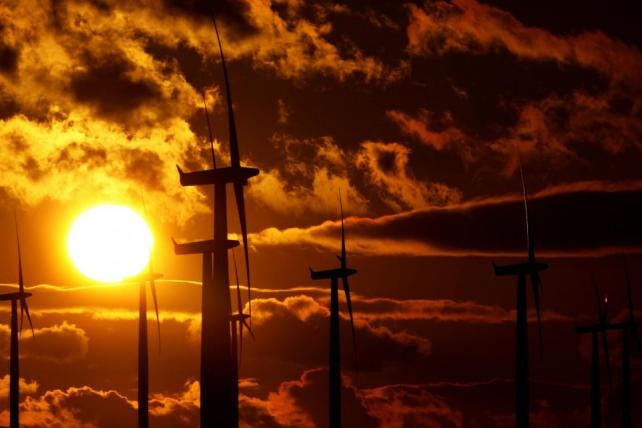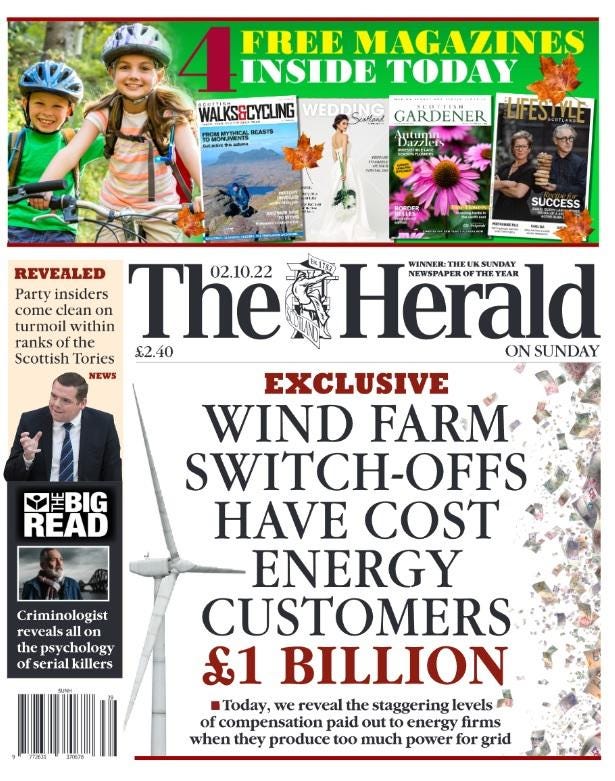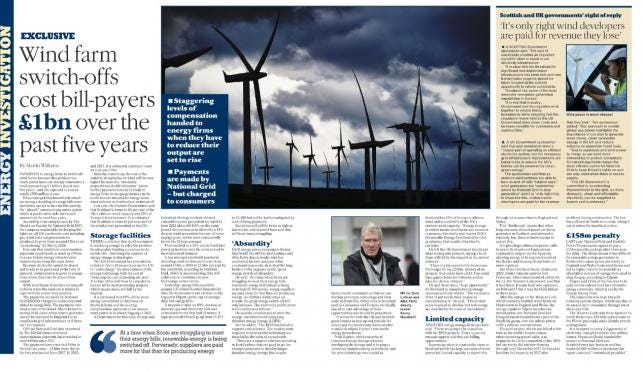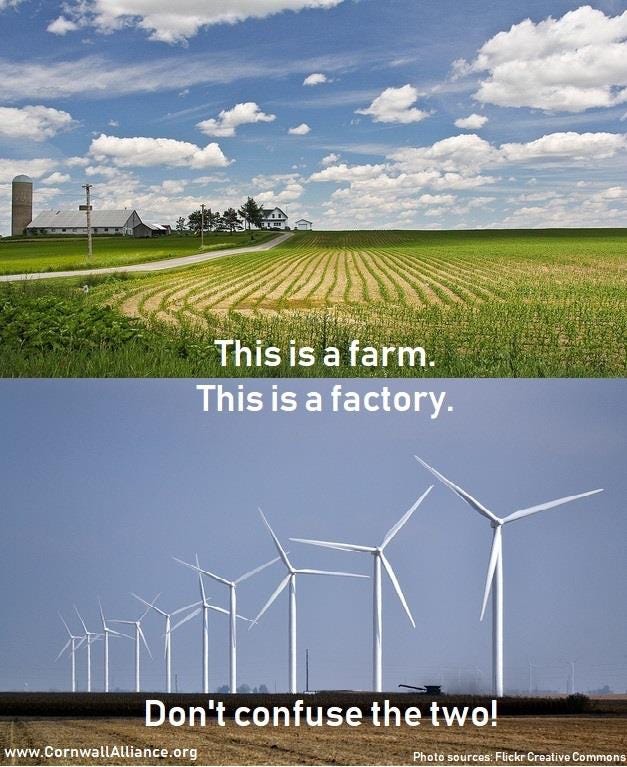"'Staggering' wind farm switch-offs cost energy customers nearly £1bn" by Martin Williams for The Herald
'Perversely, energy suppliers are paid more to switch-off wind turbines than for producing energy.'
Most of this past week my time has been consumed by the current “early engagement consultation” by Bute Energy in relation to Nant Mithil Energy Park which they plan to construct atop the domed hills of the ancient sacred landscape of the Radnor Forest where legend has it, the last dragon of Wales sleeps.
My focus has been drawn back once again to the scam of renewable energy pushed by local and national governments worldwide in order to combat ‘climate change.’
This article is important, especially since most people are not aware that wind “farms” are paid to switch-off in order to prevent disruptions in the National Grid which their unreliable, intermittent production of energy cause. It’s either too much or the exact opposite. See Wind Lulls, the reality of which is also mentioned in the article below.
In fact, when we attended the public consultation in New Radnor last week, one of the Bute Energy representatives, (of which there were many in relation to the small community) mentioned one of their talking points – that Nant Mithil would not receive any taxpayer funded subsidies. I asked if they would receive constraint payments. He did not even know what constraint payments were.
Please note that although this article provides a good overview of constraint payments paid for by us via tariffs tacked onto our ever-increasing electricity bills, it still promotes industrial wind installations and “renewable energy” as clean, green and less expensive than fossil fuels which they are most certainly not.
This paragraph in particular is a jaw dropper:
“Gas is expensive and wind power is cheap, so we need more renewables to protect consumers. Constraint payments remain the most efficient option for National Grid to keep Britain’s lights on and are only used when there is excess supply. The Government is committed to accelerating improvements to the grid, so more domestic, clean and affordable electricity can be supplied to homes and businesses.
Here is the article published by The Herald of Scotland.
'Staggering' wind farm switch-offs cost energy customers nearly £1bn
By Martin Williams • 3 October 2022 • The Herald
PAYMENTS to energy firms to switch off mainly Scottish wind farm turbines because they produce too much power have cost bill-payers approaching £1bn in just over five years and are expected to soar to £500m a year.
It has emerged that households who are seeing a doubling of energy bills since last winter are set to face further pain by the "absurd" constraint payments system which is predicted to dole out record amounts in the next four years.
According to an analysis seen by the Herald on Sunday by National Grid ESO, the company responsible for keeping the lights on, all UK constraint costs including gas, wind and coal generation are predicted to grow from around £1bn to an "eyewatering" £2.3bn by 2026.
It means that wind farm compensation payments could reach as much as £500m in a year before energy infrastructure improvement bring the costs down.
Because electricity cannot be stored and needs to be generated at the time of demand, compensation is given to energy firms when they have to reduce their output. With wind farms it involves turning off turbines when the network is unable to cope with the power they produce.
The payments are made by the National Grid ESO but charged to consumers and added to energy bills.
The payments over wind power in Scotland which kicked in in 2010, come when what it generates cannot be exported to England due to insufficient grid infrastructure or because there isn't the demand.
Official National Grid data examined by the Herald shows that the wind compensation payments have reached £900m since 2017.
The payments have risen to £395m in the last two years - £126m more that in the two year period from 2017. In 2012 and 2013, it is estimated constraint costs were at just £19m.
Industry insiders say that the cost of the inability to capitalise on wind will be even higher because of an "absolutely preposterous double whammy" where further payments have to be made to energy firms to use gas generators in the south to meet demand for energy when wind turbines in Scotland are switched off.
Last year the Scottish Government said that Scotland is home to 60% of UK's offshore wind capacity and 25% of Europe's wind resource. It is estimated that Scotland is home to just over half of the wind power generation in the UK.
There is criticism that government is not doing enough to solve the problem by adequately funding a solution to the switch offs - involving the creation of energy storage technologies.
.
The UK government has provided an initial £6.7 million to 24 projects across the UK to "turbocharge" the development of the storage technology with the aim of "reducing the cost of meeting net zero". A further £61m will then be awarded to several of the most promising projects - which means many will fall by the wayside.
It is estimated that 80% of UK wind energy curtailment in 2020 was on Scottish farms and the soaring compensation payments comes despite wind power in Scotland flagging in 2021.
A Department for Business, Energy and Industrial Strategy analysis showed renewable power generation for April to June 2021 alone fell 9.6% on the same period last year driven by a 14 per cent drop in wind generation because of lower average gusts, which were substantially below the 10-year averages.
That resulted in a 36% rise in fossil fuel power generation over the same period to meet increased demand.
It has emerged constraint payments including wind are forecast to rise from around £1bn in 2021 to £2.5bn per year by the mid-2020s, according to the National Grid, who also are predicting they will reduce once investment in new technology comes online.
Yesterday, energy bills soared for around 1.5m Scottish households after the government pub a freeze on the regulator Ofgem's price cap on average dual fuel energy bills.
It stepped in after an 80% increase in domestic gas and electricity bills was earmarked for the first half of winter.
A typical annual bill will go up from £1,971 to £2,500 but will be further mitigated by cost-of-living payments.
But prices will still be twice as high as last winter, and charities have said that will leave many struggling.
Fair energy prices campaigner Kenny MacAskill, the MP the for East Lothian and Alba Party deputy leader who has conducted his own analysis of the constraint payments described the huge constraint payments burden to the taxpayer as the "great energy switch-off absurdity".
He said: "At a time when Scots are struggling to meet their energy bills, renewable energy in Scotland is being switched off.
"Perversely, energy suppliers are paid more for that than for producing energy. As offshore wind comes on stream, the great energy switch off will only increase. The cost to the public purse will soon become billions."
.
He said the solution was to store the energy not switch it off using Long Duration Energy Storage (LDES) But he added: "The BEIS has failed to support such schemes. The modest sums required to develop this technology are dwarfed by the costs of curtailment.
“There are a range of schemes including in East Lothian that are good to go for example proposals to develop longer duration energy storage that require government investment so that we can develop prototype technology and then scale up from that. Other sites in Scotland, such as Cockenzie and Torness, are ideally placed to take advantage of these opportunities and should be prioritised.
“It is time for both the UK and Scottish Governments to step up and to provide the action and the investment that is needed to make Scotland Europe’s renewable energy powerhouse.”
Nick Kitchin, chief executive of Cumulus Energy Storage which is developing the storage and is hoping to introduced manufacturing to Scotland said the new technology was crucial as Scotland had 25% of Europe's offshore wind and around 60% of the UK's onshore wind capacity.
"Energy storage, provided means windfarms can continue to generate electricity and receive ROCs [Renewable Energy Certificates] for this production that would otherwise be curtailed."
He felt the UK government should put more money into projects to ensure saying a lot of the projects will fall by the wayside in its current schemes.
"There is a big opportunity to increase the budget to, say £250m. Instead of six projects, they could have all 24. You could have gigafactories for batteries as they have for electric vehicles. "
He said there was a "huge opportunity" for Scotland in manufacturing the storage creating hundreds of jobs.
"The solution is there, it just needs more money to commercialise it," he said. "The modest sums required to develop this technology are dwarfed by the costs of curtailment."
Another energy storage firm executive said: "There are going to be casualties with the BEIS projects. There is just not enough support and they are killing opportunities. "
Experts say there is a particular issue in Scotland which has large amounts of wind power but limited capacity to export this through interconnectors to England and Wales.
This ‘bottleneck’ means that when large amounts of wind power are being generated in Scotland, and demand is relatively low, there is limited scope to export this.
A high-voltage submarine power cable between Scotland and England was supposed to help to cut the figure by allowing energy to be exported south of the border and keeping the turbines on more regularly.
But there have been issues.
ScottishPower's pre-launch video on the Western Link project, which it called one of engineering's greatest challenges.
In January, 2020, Italian telecom systems firm Prysmian, which manufactured cables for the £1.2 billion Western Link project, said that it had failed. It came back into operation on February 7 but it was the third failure in three years.
After the outage on the Western Link which connects Scottish wind farms via Hunterston to England and Wales the energy regulatory Ofgem launched an investigation into National Grid and Glasgow-based ScottishPower, Iberdrola, over the subsea power cable's delivery and operation.
The joint project, which was billed at the time as the world’s largest subsea interconnecting power cable, was originally due to be completed in late 2015 but electricity did not start flowing through until December 2017.
It started at less than full capacity in 2017 after problems during construction. The line has suffered six faults since then, taking it out of action for months at a time.
Last year, National Grid and Scottish Power Transmission agreed to pay a £158m penalty package after a two-year the delay.
The delays meant it was difficult for renewable energy generators in Scotland to export green electricity to England and Wales from windfarms and led to higher costs to households as alternative sources of energy were used to plug the gap, according to Ofgem.
Ofgem said £15 million of the fine was to be paid into its redress fund for vulnerable energy customers, which is run by the Energy Saving Trust.
The remainder was to go towards reducing system charges, which was due to be passed on to consumers through lower electricity bills.
The Western Link runs from Ayrshire to north Wales via a 239-mile subsea route to the Wirral peninsula and a 20-mile stretch underground. It is designed to carry 2.2 gigawatts of electricity, enough to power four million homes.
Prysmian handed the project to National Grid and Scottish Power late last year and has booked €165 million in provisions for repair costs and "contractual penalties".
A UK Government spokesman said that grid constraints were a "natural part of operating an efficient electricity system, but the necessary grid infrastructure improvements are being made to ensure the UK's homes can be powered by clean, green energy".
The spokesman said that as onshore wind turbines are able to turn on and off with "relative ease", wind generators are "sometimes asked " by National Grid to stop generating and it is "only right that, in times like this, onshore wind developers are paid for the revenue that they lose".
The spokesman added: “Our exposure to volatile global gas prices highlights the importance of our plan to generate more cheap, clean renewable energy in the UK and reduce reliance on expensive fossil fuels.
“Gas is expensive and wind power is cheap, so we need more renewables to protect consumers. Constraint payments remain the most efficient option for National Grid to keep Britain’s lights on and are only used when there is excess supply. The Government is committed to accelerating improvements to the grid, so more domestic, clean and affordable electricity can be supplied to homes and businesses.”
A Scottish Government spokesman said: “The cost of constraints provides an important signal for when to invest in our electricity infrastructure. It is clear that the threshold for significant new transmission infrastructure has been met and new transmission projects should be taken forward at the earliest opportunity to relieve constraints.
“Scotland has some of the most extensive renewable generation capabilities in Europe. It is vital that industry, government and the regulator work together to enable timely investments while ensuring that the regulatory levers held by the UK Government drive down costs and increase benefits for customers and communities.”
Dr. John Constable’s Renewable Energy Foundation (REF) has been keeping track of constraint payments to industrial wind installation (not farm) operators for years. The screenshot below is from the website which tracks these payments.
According to this chart, industrial wind turbine operators in the UK have been paid £285,538,961 from 1 January to 1 October just this year.
In my opinion and many others who bother to look behind the rhetoric and propaganda of the faux green “renewable” lobby and its wealthy, often foreign backers, the push to carpet rural landscapes with these bird, bat, insect and habitat destroying monstrosities will only compound the manufactured energy crisis.
Postcript:
Related posts:











Shared to GETTR - I admire your patience wading through this labyrinth of bonkersville.
It is so mind-bogglingly confusing! The end result is always the same: We pay more, no matter what!